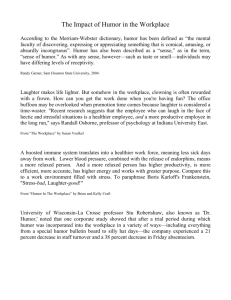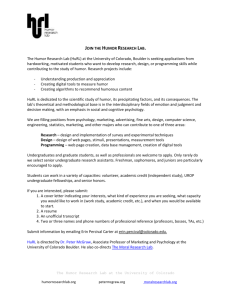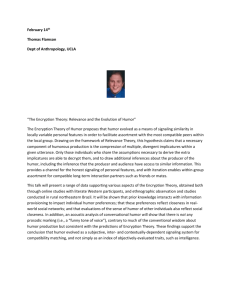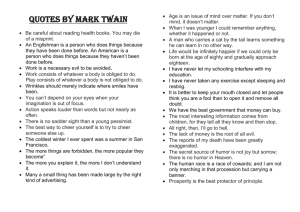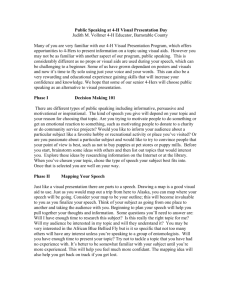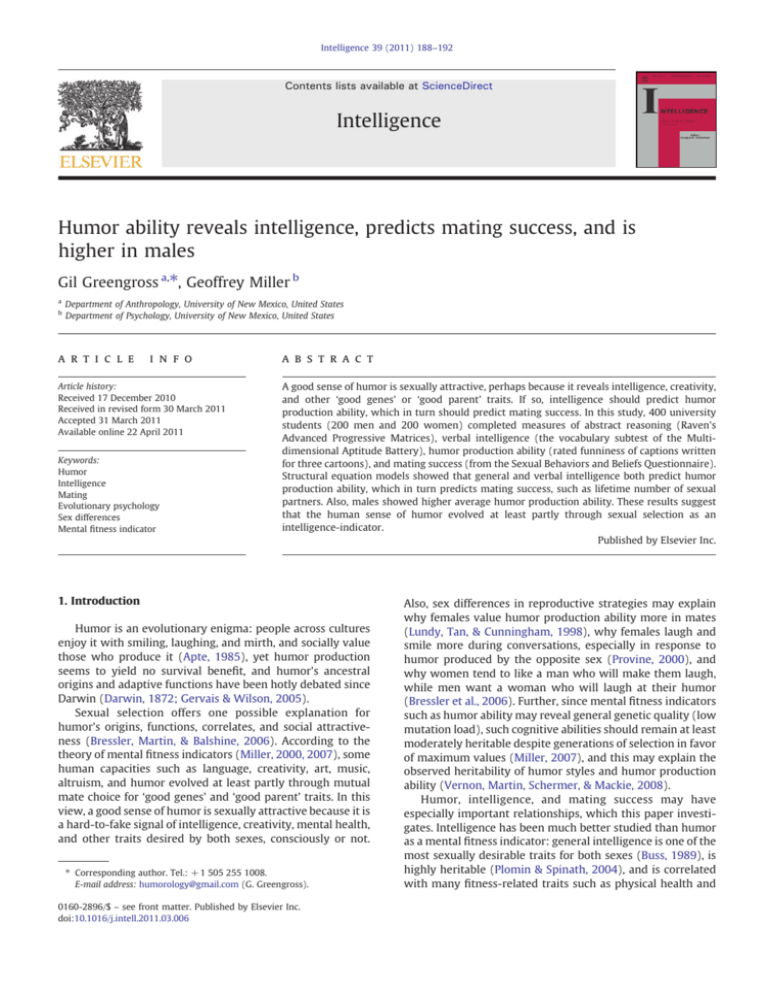
Intelligence 39 (2011) 188–192
Contents lists available at ScienceDirect
Intelligence
Humor ability reveals intelligence, predicts mating success, and is
higher in males
Gil Greengross a,⁎, Geoffrey Miller b
a
b
Department of Anthropology, University of New Mexico, United States
Department of Psychology, University of New Mexico, United States
a r t i c l e
i n f o
Article history:
Received 17 December 2010
Received in revised form 30 March 2011
Accepted 31 March 2011
Available online 22 April 2011
Keywords:
Humor
Intelligence
Mating
Evolutionary psychology
Sex differences
Mental fitness indicator
a b s t r a c t
A good sense of humor is sexually attractive, perhaps because it reveals intelligence, creativity,
and other ‘good genes’ or ‘good parent’ traits. If so, intelligence should predict humor
production ability, which in turn should predict mating success. In this study, 400 university
students (200 men and 200 women) completed measures of abstract reasoning (Raven's
Advanced Progressive Matrices), verbal intelligence (the vocabulary subtest of the Multidimensional Aptitude Battery), humor production ability (rated funniness of captions written
for three cartoons), and mating success (from the Sexual Behaviors and Beliefs Questionnaire).
Structural equation models showed that general and verbal intelligence both predict humor
production ability, which in turn predicts mating success, such as lifetime number of sexual
partners. Also, males showed higher average humor production ability. These results suggest
that the human sense of humor evolved at least partly through sexual selection as an
intelligence-indicator.
Published by Elsevier Inc.
1. Introduction
Humor is an evolutionary enigma: people across cultures
enjoy it with smiling, laughing, and mirth, and socially value
those who produce it (Apte, 1985), yet humor production
seems to yield no survival benefit, and humor's ancestral
origins and adaptive functions have been hotly debated since
Darwin (Darwin, 1872; Gervais & Wilson, 2005).
Sexual selection offers one possible explanation for
humor's origins, functions, correlates, and social attractiveness (Bressler, Martin, & Balshine, 2006). According to the
theory of mental fitness indicators (Miller, 2000, 2007), some
human capacities such as language, creativity, art, music,
altruism, and humor evolved at least partly through mutual
mate choice for ‘good genes’ and ‘good parent’ traits. In this
view, a good sense of humor is sexually attractive because it is
a hard-to-fake signal of intelligence, creativity, mental health,
and other traits desired by both sexes, consciously or not.
⁎ Corresponding author. Tel.: + 1 505 255 1008.
E-mail address: humorology@gmail.com (G. Greengross).
0160-2896/$ – see front matter. Published by Elsevier Inc.
doi:10.1016/j.intell.2011.03.006
Also, sex differences in reproductive strategies may explain
why females value humor production ability more in mates
(Lundy, Tan, & Cunningham, 1998), why females laugh and
smile more during conversations, especially in response to
humor produced by the opposite sex (Provine, 2000), and
why women tend to like a man who will make them laugh,
while men want a woman who will laugh at their humor
(Bressler et al., 2006). Further, since mental fitness indicators
such as humor ability may reveal general genetic quality (low
mutation load), such cognitive abilities should remain at least
moderately heritable despite generations of selection in favor
of maximum values (Miller, 2007), and this may explain the
observed heritability of humor styles and humor production
ability (Vernon, Martin, Schermer, & Mackie, 2008).
Humor, intelligence, and mating success may have
especially important relationships, which this paper investigates. Intelligence has been much better studied than humor
as a mental fitness indicator: general intelligence is one of the
most sexually desirable traits for both sexes (Buss, 1989), is
highly heritable (Plomin & Spinath, 2004), and is correlated
with many fitness-related traits such as physical health and
G. Greengross, G. Miller / Intelligence 39 (2011) 188–192
longevity (Gottfredson & Deary, 2004), body symmetry
(Banks, Batchelor, & McDaniel, 2010), physical attractiveness
(Langlois et al., 2000) and semen quality (Arden, Gottfredson,
Miller, & Pierce, 2008).
If humor production ability is an honest indicator of
intelligence, humor production ability should positively
correlate with intelligence. There is some evidence that a
good sense of humor is associated with verbal creativity
(Kaufman, Kozbelt, Bromley, Geher, & Miller, 2008; O'Quin &
Derks, 1997) and intelligence (Feingold & Mazzella, 1993;
Howrigan & MacDonald, 2008). For example, Feingold and
Mazzella (1991) studied verbal intelligence and “humor
reasoning ability” in three samples (36 Harvard graduate
students, 59 psychology undergraduates from City University
of New York, and 52 volunteers from Central Park in New
York; total N = 147), and found moderate correlations
(r = 0.31–0.52) between the Vocabulary scale of the MultiAptitude Test and rater-judged humor production tasks, such
as writing funny captions to cartoons stripped of their
captions and writing a repartee to an absurd question,
Howrigan and MacDonald (2008) found correlations of
0.12–0.23 between general intelligence, as measured by the
Raven's Advanced Progressive Matrices, and judge-rated
humor production tasks that included humor responses to
funny emails, mock descriptions of stereotyped characters
and funny drawings, in a sample of 185 southern California
college students.
This study aims to investigate further the relationship
between humor and intelligence in the light of sexual
selection theory. We can make several predictions if the
human capacity for producing verbal humor evolved at least
partly through mutual mate choice as a mental fitness
indicator, and if male variance in reproductive success was
somewhat higher:
(1) General intelligence should predict humor ability, and
verbal intelligence especially should predict verbal
humor ability;
(2) Humor ability should predict mating success, such as lifetime number of sexual partners, even if it does not predict
reproductive success given modern contraception;
(3) Given that females show stronger preferences for
humor ability than males do, humor production ability
should be higher in males on average, even if there are
no sex differences in intelligence (just as males show
higher average height due to stronger female preferences for height, even if there are no sex differences in
average health, which is a closer proxy for genetic
quality).
To test these hypotheses, we administered measures of
intelligence, humor ability, and mating success to a moderately large sample of university students.
2. Methods
2.1. Participants
Participants were 400 students (200 males and 200
females) enrolled in psychology courses at the University of
New Mexico (UNM). Average age was 20.6 years (+/−4.7,
range 18–57). Participants' self-reported ethnicity was 58%
189
White, 29% Hispanic, 5% Asian-American, 4% American Indian,
3% African American, and 2% other. UNM is a large state
university with low entrance requirements, and many
minority, nontraditional, mature, and first-generation students. Thus, UNM students show high variance (and low
restriction of range) in intelligence, sexual attitudes, mating
strategies, political values, religiosity, and other demographic,
psychometric, and mating-relevant variables.
2.2. Measures
2.2.1. Intelligence
We measured abstract reasoning ability with the 12-item
version (Winfred & Day, 1994) of Raven's Advanced Progressive Matrices (RAPM), which ask participants to choose
which of eight sub-patterns best fits into an abstract spatial
pattern. It is an excellent measure of non-verbal abstract
reasoning ability and is highly correlated with the g factor in
many studies (Jensen, 1998). We measured verbal intelligence with the 46-item vocabulary subtest of the Multidimensional Aptitude Battery (MAB), which asks participants
to choose which of five words has the meaning closest to that
of a given word (Jackson, 1984). It is a strong measure of
vocabulary size and shows fairly high correlations with the
verbal subset of the Wechsler Adult Intelligence ScaleRevised (WAIS-R) (Wechsler, 1981), and with full-scale IQ
(Carless, 2000). We combined the Raven's abstract reasoning
scores with the MAB vocabulary scores to yield an estimate of
general intelligence.
2.2.2. Humor ability
We measured capacity for producing verbal humor by using
blind ratings of participant ability to produce funny captions for
cartoons. Participants were given three cartoons without
captions from the New Yorker magazine's cartoon caption
contest (cartoons were at least one year old to reduce the
possibility of familiarity). They were instructed to write as
many funny captions as they could, for all cartoons, in 10 min.
This open-ended humor production is a reasonably valid
measure of spontaneous humor ability (Feingold & Mazzella,
1991, 1993). Later, six judges (four men and two women, all
students) rated the funniness of each caption on a scale from 1
(“not funny at all”) to 7 (“very funny”). Judges saw the captions
in a randomized order, and were blind to any characteristics of
the participants.
All scores were standardized to control for judges using the
rating scales in different ways. Participants produced an
average of 3.5 captions per cartoon. Funniness ratings were
highly skewed, with most captions rated not funny at all, and
even the funniest students producing only a few captions per
cartoon that were even moderately funny. So, from each judge's
ratings of each caption for each cartoon, we took the highestrated caption as most representative of the participant's humor
ability. Then we averaged these high scores across the six
judges and the three cartoons to yield an overall humor ability
score. Internal consistency scores (Cronbach's alphas) of ratings
across the six judges averaged 0.72 across the three cartoons,
which is somewhat higher than in other cartoon-captioning
studies (Feingold & Mazzella, 1993; Masten, 1986).
190
G. Greengross, G. Miller / Intelligence 39 (2011) 188–192
2.2.3. Mating success
Participants completed an extended version of the Sociosexual Orientation Inventory (SOI) (Simpson & Gangestad,
1991) It included nine questions (Cronbach's alpha 0.75) about
short-term mating success such as lifetime number of sexual
partners, number of one-night stands, and number of times the
participant had sex with two or more partners within a 24-hour
period (see Table 1 for the raw results). Responses to these
items were factor-analyzed to yield our measure of mating
success — a measure that emphasized quantity over quality of
mates. The questionnaire also included 9 items (Cronbach's
alpha 0.81) about attitudes towards short-term mating such as
“Sex without love is OK, morally”; these were factor-analyzed
to yield a measure of pro-promiscuity attitudes. Finally, there
were 4 items (Cronbach's alpha 0.68) such as “Religion has an
important role in my attitude towards love and sex” and
“Premarital sex is wrong”, factor-analyzed to yield a measure of
traditional family values. Mating success correlated 0.34
(pb 0.001) with pro-promiscuity attitudes and −0.10 (ns)
with family values; pro-promiscuity attitudes correlated −0.36
(pb 0.001) with family values.
3. Results
3.1. Correlations among humor, mating and intelligence
Table 2 shows the raw bivariate correlations (for males
and females separately) among the two intelligence measures (MAB vocabulary score and Raven's abstract reasoning
score), humor ability (rated caption average), mating success,
and age. In all analyses there were no raters' sex differences.
Consistent with prediction 1, both intelligence measures
predicted humor ability, for both males and females, all at
p b 0.001. For males, humor ability was correlated r = 0.44 with
MAB vocabulary and r = 0.27 with Raven's abstract reasoning;
for females, the respective correlations were r = 0.31 and
r = 0.24. The overall correlations (including both sexes) were
r = 0.38 (pb 0.001) between vocabulary score and humor
ability, and r = 0.25 (pb 0.001) between Raven's score and
humor ability. This difference in correlations was significant
(two-sided Fisher r-to-z transformations for the difference
Table 1
Male and female raw scores on the 10 mating success items.
Males
(N = 200)
Mean (SD)
Females
(N = 200)
Mean (SD)
Age at first intercourse
16.77 (1.70)
16.21 (2.48)
Acts of intercourse in the past month
6.01 (8.93)
6.69 (7.63)
No. of sex partners in the past year
1.85 (1.82)
1.78 (1.49)
Lifetime no. of sex partners
7.22 (10.37)
5.72 (6.56)
Likely no. of sex partners in the next 5 years
5.34 (10.09)
2.42 (3.29)
No. of sex partners on one occasion only
2.63 (4.97)
1.83 (2.87)
Times had intercourse with two or more
0.66 (1.55)
0.24 (0.66)
different partners within the same 24 h
Times had intercourse with two or more
1.45 (4.91)
0.94 (2.46)
different partners within the same 7 days
Times had intercourse with a new partner
2.85 (5.83)
1.73 (3.90)
within the first week of meeting
Times had intercourse with an ex-partner
2.78 (6.03)
1.80 (4.05)
more than a month after having split up
Table 2
Correlations among intelligence tests (Vocabulary and Raven's), humor
ability, mating success, and age, for males (above the diagonal, N = 200) and
females (below the diagonal N = 200).
1
1.
2.
3.
4.
5.
Vocabulary
Raven's
Humor ability
Mating success
Age
0.33 ⁎⁎⁎
0.31 ⁎⁎⁎
0.23 ⁎⁎
0.19 ⁎⁎
2
3
4
5
0.33 ⁎⁎⁎
0.44 ⁎⁎⁎
0.27 ⁎⁎⁎
0.05
− 0.14
0.13
0.37 ⁎⁎⁎
0.05
0.21 ⁎⁎
0.28 ⁎⁎
0.24 ⁎⁎
0.11
0.01
0.14
0.15 ⁎
0.12
⁎ p b 0.05.
⁎⁎ p b 0.01.
⁎⁎⁎ p b 0.001.
between the two was z = 2.1 (pb 0.05)), suggesting (unsurprisingly) that verbal intelligence more strongly predicts
capacity for verbal humor than abstract reasoning ability does.
To evaluate whether humor production can predict
mating success and pro-promiscuity attitude factors, two
backward multivariate regressions were conducted, with
average humor ability score regressed over sex, verbal
intelligence, RAPM, number of captions produced and either
mating success and pro-promiscuity attitude factor as the
dependent variable.
For the pro-promiscuity attitude factor, the final model
was significant [F (2, 274) = 73.42, adjusted R2 = 0.35,
p b 0.001], with only the sex (women = 0, men = 1) variable
as a predictor (B = 1.16, SE = 0.10, p b 0.001). Men were more
likely to have positive attitudes towards short-term, uncommitted sex. For the mating success factor, the final model was
significant [F (2, 295) = 5.36, adjusted R2 =0.03, p b 0.01],
with only the humor ability variable in the final model
(B = 0.14, SE = 0.06, p b 0.01). Participants who had higher
humor production scores were more likely to reported having
more short-term, uncommitted sex.
3.2. Structural equation models of intelligence, humor ability,
and mating success
Fig. 1 shows results of two structural equation models (one
for males and one for females) based on confirmatory factor
analyses (CFA) with EQS 6.1, to test if humor ability mediates
the effect of intelligence on mating success. Vocabulary scores
and Raven's scores were the intelligence measures; judged
funniness of cartoons 1, 2, and 3 were the humor ability
measures; the factor derived from the 10 SOI-derived sexual
history items was the mating success measure. For the male
model, χ2 = 10.262 (df = 7, p b 0.18), goodness of fit index
(GFI) = 0.977, comparative fit index (CFI) = 0.972, and the root
mean-square error of approximation (RMSEA)= 0.057. For the
female model, χ2 = 11.315 (df = 7, p b 0.13), goodness of fit
index (GFI) = 0.976, comparative fit index (CFI) = 0.964, and
the root mean-square error of approximation (RMSEA) =
0.064. The results for both sexes fit the data extremely well, and
show that humor ability strongly mediates the positive effects
of intelligence on mating success.
3.3. Sex differences
Table 3 shows sex differences in vocabulary score, Raven's
score, humor ability, number of captions produced, age, mating
G. Greengross, G. Miller / Intelligence 39 (2011) 188–192
Verbal
RAPM
.83/.70
Cartoon 1
.46/.44
.67/.65
.67/.51
Cartoon 2
.73/.79
Verbal
Humor
Intelligence
Cartoon 3
.47/.58
191
Reported
Behavior
.93/.95
.14/.23
Sexual
Behavior
Fig. 1. Structural equation model based on confirmatory factor analysis (CFA) testing the effect of intelligence on reported sexual behavior mediated by verbal
humor production. Standardized estimates for heterosexual men (left of slash for each path, N = 184) and heterosexual women (right of slash, N = 187) are
shown. All paths were significant at p b 0.5.
success, pro-promiscuity attitudes, and family values. Males
scored significantly higher on vocabulary, humor ability,
captions produced, mating success, and pro-promiscuity
attitudes (all at p b 0.01 or lower).
Regression analyses showed that even controlling for
vocabulary score and Raven's score, and number of captions
produced, men still produced funnier captions on average,
perhaps reflecting higher unconscious mating effort. There
were no significant sex differences in the correlations
between humor ability and vocabulary or Raven's scores, so
humor may be an equally reliable intelligence-indicator in
each sex.
4. Discussion
This study confirmed three predictions derived from a
sexual selection model of humor (Miller, 2000): intelligence
predicts humor ability, humor ability predicts mating success,
and males show higher average humor ability. Further,
structural equation models showed that humor ability
strongly mediates the positive effects of intelligence on
mating success, suggesting that intelligence may be sexually
attractive mainly insofar as it is manifest through verbal
humor. Humor is not just a reliable intelligence-indicator; it
may be one of the most important traits for humans seeking
mates (Smith, Waldorf, & Trembath, 1990; Sprecher & Regan,
2002). Of course, mate attraction is not the only function of
Table 3
Sex differences on key measures, comparing males (N = 200) and females
(N = 200), with positive d values (effect sizes) indicating that men scored
higher than women.
Males
Mean (SD)
Vocabulary score
Raven's score
Humor ability
No. of captions
Age
Mating success
Pro-promiscuity
attitudes
Family values
⁎ P b 0.05.
⁎⁎⁎ P b 0.001.
20.22
7.21
0.09
11.39
21.09
0.08
0.31
(6.02)
(2.45)
(0.48)
(4.14)
(5.43)
(0.66)
(0.61)
− 0.05 (0.75)
Females
Mean (SD)
18.90
6.82
− 0.09
9.85
20.12
− 0.08
− 0.32
(5.80)
(2.25)
(0.49)
(3.49)
(3.67)
(0.46)
(0.49)
0.05 (0.66)
t
d
2.24 ⁎
1.64
3.77 ⁎⁎⁎
4.02 ⁎⁎⁎
2.10 ⁎
2.39 ⁎
10.95 ⁎⁎⁎
− 1.31
0.22
0.16
0.38
0.40
0.21
0.28
1.36
0.14
humor. Humor can also be used in competing for status with
same-sex rivals (Greengross & Miller, 2008), reducing social
tensions (Chafe, 1987), and other adaptive functions (Li et al.,
2009).
The results are consistent with other humor studies.
Verbal humor is widely used in social situations and plays an
important role in attracting mates, especially for men (Lundy
et al., 1998; Provine, 2000). Men were funnier than women
on average and produced a larger number of captions,
consistent with the sexual signaling hypothesis in which
men try (unconsciously) to signal their mate quality through
their humor ability, and women are more responsive to and
discriminating about humor (Bressler & Balshine, 2006;
Miller, 2000). However, humor ability mediated the effects
of intelligence on mating success not only for men, but also
for women, suggesting that men are also discriminating about
women's humor ability as an intelligence-indicator. Notably,
pro-promiscuity attitudes were not associated with humor
ability, but higher family values scores (more religious/
moralistic attitudes towards sex) predicted lower humor
ability. Nonetheless, given that men were funnier on average
and women tend to be choosier in selecting mates, men might
be more motivated to display their humor ability.
The study had some limitations in the sample and measures
that should be addressed in further research. Although our UNM
student sample was quite diverse in intelligence, humor ability,
mating success, socioeconomic status, and ethnicity, further
studies should use larger community samples, across cultures,
and with a wider age range. Also, genetically informative
samples based on extended twin family designs would allow
calculation of additive, dominance, and epistatic genetic effects
on humor ability, and genetic correlations among intelligence,
personality, humor ability, and mating success; DNA samples
would allow genome-wide association studies of single nucleotide polymorphisms, copy number variants, and other forms of
genetic variation associated with humor ability. Further studies
should use a larger number of intelligence measures so a proper
g factor can be extracted, and should use better, more objective
measures of mating success that address quality as well as
quantity of mates. Given the dearth of well-validated humor
ability measures, future studies could potential revive some of
the older measures, such as the Sense of Humor subscale of the
George Washington University Series Social Intelligence Test
(Moss, Hunt, Omwake, & Woodward, 1955). Also, future studies
192
G. Greengross, G. Miller / Intelligence 39 (2011) 188–192
should ideally include measures not only of humor ability and
general intelligence, but also of other potentially related
constructs such as creativity, social intelligence, emotional
intelligence, the Big Five personality traits, and measures of
mental illnesses allegedly associated with verbal creativity, such
as schizotypy and hypomania. In addition, abstract reasoning
and verbal intelligence capture only some facets of intelligence,
and the results might be different if other measures of
intelligence were used (e.g. other g-factor related measures,
see Jensen, 1998). Future studies should use a variety of
intelligence scales to see how different types of intelligence
relate to humor and mating success.
Another key limitation is the somewhat artificial humor
production task: writing captions for cartoons, in the absence
of natural social interactions or potential mates, do not reflect
most everyday uses of humor. However, it seems reasonable
to suppose that people may show stable levels of humor
ability across different levels of social interactiveness, ranging
from paper-and-pencil studies such as this, through emails or
social networking sites, and stand-up comedy in front of an
audience, to more ecologically valid and ancestrally natural
forms of social interaction such as face-to-face flirtation and
conversation. On the other hand, one strength of the study is
the blind rating of humor ability, independent of other social
cues. Previous research shows that people are perceived as
funnier if they are more physically attractive, more agreeable,
or higher in status (Greengross & Miller, 2008; Lundy et al.,
1998), and blind ratings eliminate such halo effects.
In summary, the human capacity for producing and
appreciating humor may parallel the capacities of other
animals for producing and appreciating other types of
courtship displays that reliably reveal phenotypic and genetic
qualities.
Acknowledgements
We thank Steve Gangestad, Rod A. Martin, James Boone,
Scott Barry Kaufman and three anonymous reviewers for
their useful comments and suggestions.
References
Apte, M. L. (1985). Humor and laughter: An anthropological approach. Ithaca,
NY: Cornell University Press.
Arden, R., Gottfredson, L. S., Miller, G., & Pierce, A. (2008). Intelligence and
semen quality are positively correlated. Intelligence, 37, 277–282.
Banks, G. C., Batchelor, J. H., & McDaniel, M. A. (2010). Smarter people are (a
bit) more symmetrical: A meta-analysis of the relationship between
intelligence and fluctuating asymmetry. Intelligence, 38, 393–401.
Bressler, E., & Balshine, S. (2006). The influence of humor on desirability.
Evolution and Human Behavior, 27, 29–39.
Bressler, E., Martin, R. A., & Balshine, S. (2006). Production and appreciation
of humor as sexually selected traits. Evolution and Human Behavior, 27,
121–130.
Buss, D. M. (1989). Sex differences in human mate preferences: Evolutionary
hypotheses tested in 37 cultures. The Behavioral and Brain Sciences, 12,
1–49.
Carless, S. A. (2000). The validity of scores on the Multidimensional Aptitude
Battery. Educational and Psychological Measurement, 60, 592–603.
Chafe, W. (1987). Humor as a disabling mechanism. The American Behavioral
Scientist, 30, 16–26.
Darwin, C. (1872). The expression of the emotions in man and animals. London
England: John Murray.
Feingold, A., & Mazzella, R. (1991). Psychometric intelligence and verbal
humor ability. Personality & Individual Differences, 12, 427–435.
Feingold, A., & Mazzella, R. (1993). Preliminary validation of a multidimensional model of wittiness. Journal of Personality, 61, 439–456.
Gervais, M., & Wilson, D. S. (2005). The evolution and functions of laughter
and humor: a synthetic approach. The Quarterly Review of Biology, 80,
395–430.
Gottfredson, L. S., & Deary, I. J. (2004). Intelligence predicts health and
longevity, but why? Current Directions in Psychological Science, 13, 1–4.
Greengross, G., & Miller, G. F. (2008). Dissing oneself versus dissing rivals:
Effects of status, personality, and sex on the short-term and long-term
attractiveness of self-deprecating and other-deprecating humor. Evolutionary Psychology, 6, 393–408.
Howrigan, D. P., & MacDonald, K. B. (2008). Humor as a mental fitness
indicator. Evolutionary Psychology, 6, 652–666.
Jackson, D. N. (1984). Multidimensional Aptitude Battery: Manual. Port Huron,
MI: Research Psychologists Press.
Jensen, A. R. (1998). The g factor: The science of mental ability. Westport, CT
US: Praeger Publishers/Greenwood Publishing Group.
Kaufman, S. B., Kozbelt, A., Bromley, M. L., Geher, G., & Miller, G. (2008). The
role of creativity and humor in human mate selection. In G. Geher & G.
Miller (Eds.), Mating intelligence: Sex, relationships, and the mind's
reproductive system (pp. 227–262). Mahwah, NJ, US: Lawrence Erlbaum
Associates Publishers.
Langlois, J. H., Kalakanis, L., Rubenstein, A. J., Larson, A., Hallam, M., & Smoot,
M. (2000). Maxims or myths of beauty? A meta-analytic and theoretical
review. Psychological Bulletin, 126, 390–423.
Li, N. P., Griskevicius, V., Durante, K. M., Jonason, P. K., Pasisz, D. J., & Aumer, K.
(2009). An evolutionary perspective on humor: sexual selection or
interest indication? Personality and Social Psychology Bulletin, 35,
923–936.
Lundy, D. E., Tan, J., & Cunningham, M. R. (1998). Heterosexual romantic
preferences: the importance of humor and physical attractiveness for
different types of relationships. Personal Relationships, 5, 311–325.
Masten, A. S. (1986). Humor and competence in school-aged children. Child
Development, 57, 461–473.
Miller, G. (2000). The mating mind: How sexual selection shaped the evolution
of human nature. New York: Anchor books.
Miller, G. (2007). Sexual selection for moral virtues. The Quarterly Review of
Biology, 82, 97–125.
Moss, F. A., Hunt, T., Omwake, K. T., & Woodward, L. G. (1955). Manual for the
George Washington University Series Social Intelligence Test. Washington,
D.C.: Center for Psychological Service.
O'Quin, K., & Derks, P. (1997). Humor and creativity: A review of the
empirical literature. In M. Runco (Ed.), Creativity research handbook,
vol. 1. (pp. 223–252)Cresskill, NJ: Hampton Press.
Plomin, R., & Spinath, F. M. (2004). Intelligence: genetics, genes, and
genomics. Journal of Personality and Social Psychology, 86, 112–129.
Provine, R. (2000). Laughter: A scientific investigation. New York: Viking.
Simpson, J. A., & Gangestad, S. W. (1991). Individual differences in
sociosexuality: Evidence for convergent and discriminant validity.
Journal of Personality and Social Psychology, 60, 870–883.
Smith, J. E., Waldorf, V. A., & Trembath, D. L. (1990). Single white male
looking for thin, very attractive…. Sex Roles, 23, 675–685.
Sprecher, S., & Regan, P. C. (2002). Liking some things (in some people) more
than others: Partner preferences in romantic relationships and friendships. Journal of Social and Personal Relationships, 19, 463–481.
Vernon, P., Martin, R. A., Schermer, J. A., & Mackie, A. (2008). A behavioral
genetic investigation of humor styles and their correlations with the big5 personality dimensions. Personality and Individual Differences, 44,
1116–1125.
Wechsler, D. (1981). Wechsler Adult Intelligence Scale-Revised. New York:
Psychological Corporation.
Winfred, A., & Day, D. (1994). Development of a short form for the Raven
Advanced Progressive Matrices Test. Educational and Psychological
Measurement, 54, 394–403.


